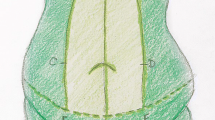Abstract
Background
The post-bariatric surgery patient presents several challenges to the surgeon. Correction of skin and subcutaneous redundancy can be difficult, particularly in massive-weight-loss patients with horizontal laxity, upper abdominal or flank laxity, and “double-roll” deformities. The aim of our study was to propose our modification of the “vest-over-pants” abdominoplasty technique to exploit all the advantages of the Planas technique in bariatric surgery patients and to solve the problem of extreme epigastric skin redundancy in difficult abdominal contour cases.
Methods
Sixteen post-bariatric surgery patients (10 females and 6 males, nonsmokers) with moderate to severe epigastric skin laxity were enrolled in the study. They all had undergone a biliopancreatic diversion (BPD) by laparotomy and had undergone this body-contouring procedure from 2006 to 2010.
Results
After the inverted-Y abdominoplasty, 12 patients (75 %) had an uneventful recovery. On the other hand, one subject (6.25 %) had a seroma and four (25 %) had wound dehiscence and delayed wound healing. No skin necrosis was reported. In one patient (6.25 %) scar revision in areas that had delayed healing was performed. The addition of a vertical incision has not led to an increased rate of postoperative complications, but the rates are in line with the satisfactory results described with the Planas technique in bariatric surgery patients. In addition, various advantages have been observed compared to traditional vertical resection patterns.
Conclusion
This case series has quantitative limitations and further investigations are needed. However, this study suggests that inverted-Y abdominoplasty could be a good compromise between the need to minimize complication rates and ensure an optimum aesthetic result and patient satisfaction rate in some abdominal defects in massive-weight-loss patients.
Level of Evidence IV
This journal requires that authors assign a level of evidence to each article. For a full description of these Evidence-Based Medicine ratings, please refer to the Table of Contents or the online Instructions to Authors www.springer.com/00266.







Similar content being viewed by others
References
Bracaglia R, Tambasco D, Gentileschi S et al (2011) Abdominoplasty in patient with penile implant. Aesthet Plast Surg 35:933–935
Bracaglia R, D’Ettorre M, Gniuli D et al (2011) Morbidly obese patients undergoing bariatric and body contouring surgery: psychological evaluation after treatments. J Plast Reconstr Aesthet Surg 64:1246–1248
Maggard MA, Shugarman LR, Suttorp M et al (2005) Meta-analysis: surgical treatment of obesity. Ann Intern Med 142:547–559
Obeid F, Falvo A, Dabideen H et al (2005) Open Roux-en-Y gastric bypass in 925 patients without mortality. Am J Surg 189:352–356
D’Ettorre M, Gniuli D, Iaconelli A et al (2010) Wound healing process in post-bariatric patients: an experimental evaluation. Obes Surg 20:1552–1558
American Society of Plastic Surgeons. 2010 Plastic surgery procedural statistics. http://www.plasticsurgery.org/News-and-Resources/Statistics.html. Accessed 26 July 2011
Strauch B, Herman C, Rohde C et al (2006) Mid-body contouring in the post-bariatric surgery patient. Plast Reconstr Surg 117:2200–2211
Young SC, Freiberg A (1991) A critical look at abdominal lipectomy following morbid obesity surgery. Aesthet Plast Surg 15:81
Carwell GR, Horton CE (1997) Circumferential torsoplasty. Ann Plast Surg 38:213
Bracaglia R, D’Ettorre M, Gentileschi S, Tambasco D (2012) “Vest over pants” abdominoplasty in post-bariatric patients. Aesthet Plast Surg 36:23–27
Planas J (1978) The “vest over pants” abdominoplasty. Plast Recontr Surg 61:694–700
Planas J, Bisbal J, del Cacho C et al (1988) Further advantages of the “vest over pants” abdominoplasty. Aesthet Plast Surg 12:123–127
Strasser EJ (1999) An objective grading system for the evaluation of cosmetic surgical results. Plast Reconstr Surg 104:2282–2285
Mauro M, Taylor V, Wharton S et al (2008) Barriers to obesity treatment. Eur J Intern Med 19:173–180
Greco JA III, Castaldo ET, Nanney LB et al (2008) The effect of weight loss surgery and body mass index on wound complications after abdominal contouring operations. Ann Plast Surg 61:235–242
Larsen M, Polat F, Stook FP et al (2007) Satisfaction and complications in post-bariatric surgery abdominoplasty patients. Acta Chir Plast 49:95–98
Neaman KC, Hansen JE (2007) Analysis of complications from abdominoplasty—a review of 206 cases at university hospital. Ann Plast Surg 58:292–298
Arthurs ZM, Cuadrado D, Sohn V et al (2007) Post-bariatric panniculectomy: pre-panniculectomy body-mass index impacts the complication profile. Am J Surg 193:567–570
Vastine VL, Morgan RF, Williams GS et al (1999) Wound complications of abdominoplasty in obese patients. Ann Plast Surg 42:34–39
Leahy PJ, Shorten SM, Lawrence WT (2008) Maximizing the aesthetic result in panniculectomy after massive weight loss. Plast Reconstr Surg 122:1214–1224
Borud LJ, Warren AG (2007) Modified vertical abdominoplasty in the massive weight loss patient. Plast Reconstr Surg 119:1911–1921
Ramsey-Stewart G (1993) Radical “fleur-de-lis” abdominal after bariatric surgery. Obes Surg 3:410–414
D’Ettorre M, Gniuli D, Bracaglia R et al (2012) Micro- and macroscopic structural modification of subcutaneous adipose tissue after bariatric surgery. Aesthet Plast Surg 36(1):213–214
Migliori F, Rosati C, D’Alessandro G et al (2006) Body contouring after biliopancreatic diversion. Obes Surg 16:1638–1644
Duff CG, Aslam S, Griffiths RW (2003) Fleur-de-lys abdominoplasty: a consecutive case series. Br J Plast Surg 56:557–566
Pollock H, Pollock T (2000) Progressive tension sutures: a technique to reduce local complications in abdominoplasty. Plast Reconstr Surg 105:2583–2586
de Castro CC, Aboudib Junior JH, Salema R (1993) How to deal with abdominoplasty in an abdomen with a scar. Aesthet Plast Surg 17:67–71
Conflict of interest
The authors have no conflicts of interest to disclose.
Author information
Authors and Affiliations
Corresponding author
Rights and permissions
About this article
Cite this article
Bracaglia, R., Tambasco, D., D’Ettorre, M. et al. “Inverted-Y”: A Modified Vest-Over-Pants Abdominoplasty Pattern Following Bariatric Surgery. Aesth Plast Surg 36, 1179–1185 (2012). https://doi.org/10.1007/s00266-012-9956-4
Received:
Accepted:
Published:
Issue Date:
DOI: https://doi.org/10.1007/s00266-012-9956-4




